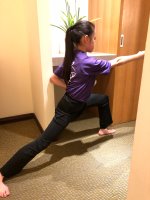


Basic Stances
1.Horse Stance
The Horse Stance is the foundation of all Chinese martial arts. It is a fundamental stance that trains leg strength as well as "neigong" , or internal strength.
How to do the Horse Stance:
The Horse Stance is divided into the "Wide Horse" and "Narrow Horse" according to the space between the legs.
To do the Horse Stance, stand up straight and position your feet to be about three feet apart from each other. Squat down, making sure that your feet are both facing forward and that your thighs are parallel with the ground. Your buttocks must not protrude from the rest of your torso.
It is difficult to remain in this stance for an extended period of time without rigorous and continuous training. To be able to remain in the Horse Stance for five minutes is laudable, but to be able to last thirty minutes is an achievement in itself. |
 |
2.Bow Stance
The Bow Stance is a fundamental training stance that rectifies human posture and builds lower body strength.
How to do the Bow Stance:
To do the Bow Stance, take a big step forward with one foot. Bend your extended knee until your thigh is nearly parallel to the ground and your knee is perpendicular to the sole of your foot. Straighten your other leg. Both feet should make full contact with the ground, and your entire torso starting from your head and ending at your tailbone should remain aligned along a single vertical line. |
 |
3.Empty Stance
The Empty Stance relies on the back leg to support most of the body’s weight, so that one may shift to other positions with the other leg. As a result, leg strength is crucial to an agile Empty Stance.
How to do the Empty Stance:
To do the Empty Stance, have one foot in front of another, about three shoe sizes apart.. Squat down, letting your weight rest on your back leg until the thigh of your back leg is almost parallel to the ground and the sole makes full contact with the ground. Your front leg should be slightly bent. |
 |
4.Flat Stance
The Flat Stance is a common fundamental training stance that trains leg muscles while stretching them at the same time. It is beneficial to leg stability as well as the overall stability of one's form.
How to do the Flat Stance:
To do the Flat Stance, extend one leg fully to your side and squat down, leaning toward the opposite direction of the extended leg. The soles of your feet should both face wherever you are facing, and the spine should be straight. Try to keep your torso as vertical as possible. |
 |
5.Rest Stance
The Resting Stance is a unique training position that puts its emphasis on twisting the body. It builds stability for when movements involve spins or sharp turns.
How to do the Resting Stance:
To do the Resting Stance, cross your legs and close them. Squat all the way down so that your left foot makes full contact with the ground, and your toes face outwards. Only the front of the sole of your right foot should be on the ground, and your right knee should be pressed tight against the outside of your left calf. Rest your buttocks on your right heel. |
 |

Taiwan © 2019 Cyber Fair
Taipei Fuhsing Private School
Best viewed at a screen resolution of 1280x1024 pixels








